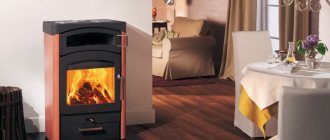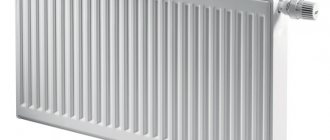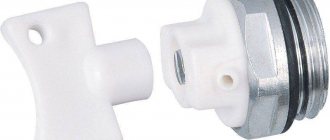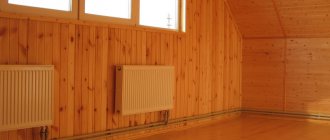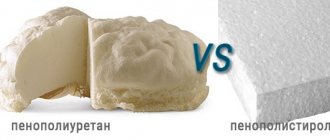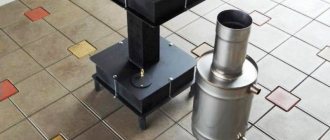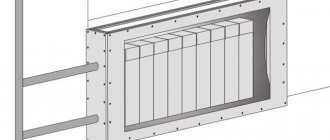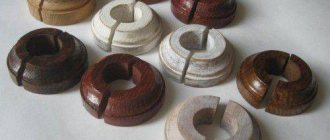When arranging their own home, many homeowners are faced with the problem of choosing radiators for heating structures. A fairly good option are steel radiators whose technical characteristics are impressive.
Information regarding the technical characteristics of heating devices, and more specifically:
- working and testing pressure;
- coolant temperature;
- other parameters that influence the efficiency of a particular model.
This information is completely understandable for every consumer. This article talks about the technical characteristics of steel heating radiators.
Heating batteries made of steel come in two types:
Panel type steel radiators
The peculiarity of such devices as steel panel heating radiators is that they combine the properties of a convector and a battery. They are usually produced in the form of rectangular panels of different thicknesses and dimensions. In the photo you can see what they look like.
The design of steel heating panel radiators is simple:
- the base of the device is a panel consisting of two profiled steel plates, which are connected along the perimeter with a weld. Inside, vertically located oblong channels are formed from steel using the stamping method. Hot coolant circulates through them during the heating process;
- U-shaped ribs are welded to the panels on the back side, resulting in more efficient heat transfer. This element for convective heating of a room is made from cold-rolled steel, only thinner;
- the design of one device can consist of the three panels described above. In the case of connecting several panels into a single system, manufacturers cover them using side covers;
- A steel panel heating radiator can have a variety of dimensions. Most models presented on the domestic market have heights from 300 to 900 millimeters and widths from 400 to 3000 millimeters. The depth of the panel device depends on the number of steel panels and can reach 170 millimeters.
According to connection options, panel radiators are:
- with side connection;
- with bottom connection;
- with universal connection.
In terms of cost, the most expensive models are those with a lower connection option, since they often have a thermostat built into them. If the device does not have a built-in thermostat, it is connected using a special thermostatic valve.
Panel steel radiators have technical characteristics depending on the model:
- operating pressure in the range of 6 - 8.5 atmospheres;
- crimping pressure does not exceed 13 atmospheres;
- The maximum temperature of the coolant is no more than 110 – 120 °C.
The fact that the testing pressure is low is the reason why experts in the field of heating engineering do not recommend installing steel panel radiators in multi-storey buildings.
Manufacturers of steel appliances
On the heating equipment market, steel radiators are represented by models from many manufacturers, but the manufacturing technology practically does not differ, and the cost may differ slightly.
Steel tubular radiators are assembled from stamped sections welded together by spot welding
The price of a product is determined by its size, brand, design. It is often possible to purchase a high-quality domestic device that is not inferior in its characteristics to a world-famous brand.
Among the domestic companies whose products are in stable demand in our market are the following:
- Lidea;
- Prado;
- Conrad.
Lideya devices are manufactured in Belarus. They are equipped with 1-2-3 panels, the volume of coolant in which is in the range of 0.9-6.55 liters and depends on the size. Radiator power with one panel is 2.1 kW, with two panels – 3.9 kW, with three panels – 5.6 kW. Steel thickness 1.2 mm, operating pressure 8.9 bar.
Prado heating equipment is manufactured in Izhevsk. It is equipped with 1-2 panels, the volume of coolant varies between 0.8-5.7 liters. As for power, a radiator with one panel has 1.4 kW, with two panels it has 2.3 kW. Steel thickness 1.4 mm, operating pressure 8.8 bar.
Conrad batteries are manufactured in St. Petersburg. They are equipped with 1-2 panels, the volume of coolant in which is 0.85-5.2 liters and depends on the size. The power of the device with one panel is 1.35 kW, with two panels – 2.3 kW. Steel thickness 1.4 mm, working pressure 10 bar.
Among European manufacturers of tubular steel batteries, German and Italian companies have proven themselves well: Charleston , Kermi , Arbonia , Israp Tesi .
Also the most popular are panel heating radiators made in Germany by Kermi and Buderu s, and by the Finnish company PURMO . Almost in no way inferior to them in quality and popularity are Delonghi from Italy, as well as Korado of Czech origin.
Models of panel and tubular radiators made in Europe have different dimensions and power. Technical characteristics are presented in the passport of each model.
A well-known brand will cost an order of magnitude more than equipment from less popular companies. But purchasing a branded device guarantees the purchase of a device of appropriate European quality
Steel radiators are among the most popular heating devices. Due to their presentable appearance, affordable price and high heat output, they are widely used in offices, houses and apartments. The maximum service life of steel radiators is achieved in autonomous heating systems.
Tubular steel heating radiators
The design of tubular radiators can be very attractive; they are often made in the form of interior items, as in the photo. They have the following parameters: height 190 – 3000 millimeters, depth – no more than 225 millimeters, length has no limit.
Experts recommend: if tubular steel heating radiators are installed under a window, make sure that their length is at least 75% of the width of the window opening.
These devices have the following parameters:
- working pressure not higher than 12 atmospheres;
- crimping pressure up to 25 atmospheres;
- maximum coolant temperature 120 °C.
Since tubular devices can withstand strong water hammer, they are considered an ideal solution for installation in apartments of multi-story buildings.
Cast iron sectional radiators
The first development of cast iron batteries was carried out almost 150 years ago by our compatriot. A few years later, the Americans received the patent and finalized the design. Radiators gained popularity after the advent of the central heating system, and their mass production began during the Industrial Revolution.
The batteries that were used in the USSR and now remain in many homes are branded MC 140. The value “140” is the power supplied by one section. The operating and test pressure of the battery is 9 and 18 atmospheres, respectively. Number of sections – from 4 to 10.
Today, cast iron radiators are again gaining popularity, thanks to improvements in their design and design.
The advantages and disadvantages of batteries of this type are approximately the same.
- Long service life (more than 50 years);
- Affordable price;
- Resistance to mechanical damage;
- Corrosion resistance;
- High abrasive wear. Pebbles and sand in water do not cause much damage to the battery from the inside;
- Heating efficiency with the maximum number of sections.
- Heavy weight and bulkiness;
- Possibility of depressurization of joints;
- Accumulation of rust inside during long-term use;
- Unpresentable appearance;
- Difficulty in integrating radiators into autonomous heating systems, the impossibility of saving on coolant;
- Difficulty in cleaning.
Cast iron radiators in a modern style
The oldest type of radiators. These radiators are distinguished by simplicity and severity of form, flat facade, and neat design. They take a long time to warm up, but they withstand all the hardships of central heating with honor. They are durable, cheap, and last for 50 years. Therefore, when deciding which types of heating radiators to choose, many choose cast iron ones.
Manufacturers: Budget cast iron radiators are produced by Ukrainian, Russian, and Belarusian factories. But foreign products will be of better quality and prettier in appearance. Let us note the companies Konner, Viadrus, DemirDöküm, Roca.
Radiators in retro style
Each of these radiators is a small masterpiece. After all, artistic cast iron looks very elegant, decorating any room. Unfortunately, each such battery is very expensive.
Manufacturers: These are companies from England, Germany, France, Turkey, China. For example, the companies Roca and Konner produce very beautiful models.
+Pros:
- They can work for at least 50 years.
- Cast iron is chemically passive, so it is too tough for corrosion.
- Beam radiation warms up a room with high ceilings well.
- When the heating is turned off, the batteries remain hot for a long time.
- Low price (except for models made by artistic casting).
-Minuses:
- Long warm up.
- Large weight and dimensions cause difficulties during transportation and installation.
- Radiators need strong mounting.
- Large volume of coolant.
- Cast iron is a brittle metal. Water hammer can rupture a cast iron battery.
Main characteristics:
- Pressure (working) – 9-12 bar.
- Thermal power (1 section) – 100-160 watts.
- Hot water temperature (maximum) – 110 degrees.
Flat steel radiators: technical specifications
The flat steel heating radiator is the most popular device in Europe today. Its widespread use is due to its compactness. In addition, they are adapted for automated heating systems, and the technical characteristics of steel heating radiators are simply amazing.
Steel plate heating radiators are available in single-row, double-row and three-row designs. Additionally, they are equipped with convective fins.
To produce steel flat heating radiators, manufacturers use cold-rolled steel, which is durable and resistant to corrosion.
Design and principle of operation of flat batteries
For the manufacture of steel flat heating radiators, stamped metal sheets connected to each other are used. High-tech welding contributes to the formation of reliable, durable joints.
Two connected panel planes exhibit a high degree of heat transfer; a small internal cavity is formed in them, through which the coolant circulates. In order to use the equipment as rationally as possible, you need to adhere to the recommended temperature regime. To optimize fuel consumption, fins were added to the planes, resulting in the formation of a new class of technology - convection finned batteries. Additional elements are attached to the surface using spot welding; in cross-section, the equipment has the shape of a trapezoid.
Flat batteries in the upper part are equipped with perforations - these are zones for the exit of heated air. The casing contains metal pipes with radiator plates. The working fluid, circulating through the tubes, releases part of the heated air; the flow path also passes through the upper zone with metal perforations. In the process of heating the front part, a little more thermal energy is released.
Flat radiators are optimal for closed-type heating systems; they are not advisable to install in centralized networks. These devices work with coolants exhibiting low pressure levels.
Advantages and disadvantages of stainless steel radiators
When comparing the performance characteristics of steel batteries with devices made of other materials, heating radiators made of stainless steel have advantages in a number of indicators:
- Due to the simplicity of the design, they have a long service life. High-quality heating devices are made of thick steel (1.2 - 1.5 millimeters), which has a positive effect on their strength;
- The presence of different options makes it much easier to install steel radiators yourself. On the website of well-known manufacturers there are always instructions that clearly and in detail explain how the device should be connected for different heating design schemes;
- The design of steel radiators makes them one of the worthy components of an apartment’s interior.
Types of steel heating radiators
Steel heating radiators can be divided into three types according to design features:
Panel flat
Such a battery consists of two steel plates in which recesses with a flat bottom . When two plates are connected, channels for coolant circulation.
The plates are fastened using spot welding. The device has holes in the corners for incoming and outgoing water. an air bleed valve on one of the fittings
A tap is installed on the pipe through which the coolant enters the heater to regulate the water supply.
These models have a convection function . Convection fins are located on the side that is attached to the wall. When the heater heats up, these fins also heat up. Hot air rises, forming natural convection, which speeds up the heating of the room.
Important! Some models of steel panel heating devices do not have convection fins .
One radiator can accommodate from one to three panels . Depending on their number, as well as the presence of a convection function, there are 7 types of panel heaters:
- 10 - has one panel. It does not have a convector or cladding.
- 11 - has one panel and a convector.
- 20 - has two panels and an air outlet grille on top. There is no convector.
- 21 - two-panel heater with a protective casing and a convector attached to one of the panels.
- 22 - two-panel device with protective covers and convectors.
- 30 - three-panel radiator, covered with an air outlet grille on top.
- 31 is a three-panel device with protective covers and a convector.
Photo 1. Internal structure of some types of steel panel radiators, small and large.
Tubular or sectional
Some tubular heaters are similar to conventional cast iron sectional batteries. They are also called sectional, since the coolant circulates in them through sections connected into a single structure.
One section of such a device can have from 2 to 6 tubes . Tubular heating devices can have any size. The lowest height is 0.19 m , and the maximum is 3 meters.
Lamellar
Plate heaters consist of a large number of plates, a heat exchanger and a casing.
The heat exchanger is an arc-shaped pipe. The number of pipe bends (bends) depends on the specific model. As a rule, one or two elbows are used.
The pipe is heated by the coolant and then transfers heat to the plates. The plates act as a convector , but the convection created by the ribs of panel heating devices is much stronger.
The protective cover has two functions . Due to the fact that the plates and pipe are very hot from the coolant, they can burn the residents of the house. The casing temperature does not exceed 40 °C . In addition, this casing plays an aesthetic role. Externally, such batteries are similar to panel batteries.
The technical characteristics of steel plate heaters are such that they can be part of the heating systems of panel houses, as they can withstand pressure up to 40 atmospheres.
Attention! Over time, the heat transfer of steel plate heating devices decreases due to dust settling on parts of the structure. To avoid this, the device must be cleaned periodically.
Operating requirements
Thin steel heating radiator type 11 in the interior of the house.
Steel appliances should be used in enclosed areas where there is no harmful corrosive effect and moisture will not form on their surface. For example, you should not install steel equipment in bathrooms, laundries, baths, halls, swimming pools, car washes, and refrigerators. For the same reason, they cannot be installed in houses in the first year after completion of construction or during modernization, if the premises will not be heated.
Flat radiators can be used in both single-pipe and two-pipe heating systems, using pipes made of various materials: steel, copper or plastic, in which water or a special glycol mixture can be used as a coolant. Polypropylene pipes must be reinforced with a solid layer of aluminum to avoid oxygen diffusion (the penetration of air into the heating system from the outside, which can cause corrosion processes), and metal fittings and fittings must be used with them.
Flat radiators can be installed for systems with membrane expansion tanks. Here it is necessary to use tanks whose membrane is made of “Butyl” material, which protects the heating system from air penetration.
Also, the assembly of thin radiators is permitted in small open systems with forced circulation with limited thermal output, but provided that approved corrosion inhibitors are used. Please note that flat heaters are not used in systems with natural circulation of coolant, because it is impossible to ensure their sufficient heat transfer.
It is prohibited to install radiators in systems where the maximum operating pressure may exceed 9-10 bar and the operating temperature above 110-120°C. When checking the tightness of the system, the pressure should not exceed 12-13 bar. These values are typical for devices from the most famous manufacturers; More detailed information can be found in the equipment documentation.
Installations with steel radiators must be filled and topped up with water of the appropriate quality. Requirements for water characteristics vary from manufacturer to manufacturer, but the averages are as follows:
- the total content of chloride ions and sulfate ions is not higher than 150 mg/l (for copper pipes - not higher than 50 mg/l),
- oxygen content not higher than 0.1 mg/l,
- Water pH within 7.0 ÷ 10.0,
- water hardness is not higher than 4.0.
It is unacceptable to empty the heating system of water, except during failures. If an emergency arises, for example, during repairs, water should be removed only from the part where the work will be carried out. Once completed, the system must be immediately filled with water.
Annual water losses in the heating system should not exceed 5% for a closed system and 10% for an open one.
Flat-plate radiators should be cared for using cleaning agents that do not contain solvents, acids or other substances that cause damage to the paintwork and, as a result, corrosion.
Technical characteristics of steel batteries
Battery specifications include:
- heat transfer;
- inertia;
- operating pressure.
Each type of heating structure has its own technical features. Heat transfer depends on several factors:
- sizes ;
- presence of a protective casing;
- functions ;
- masses.
The protective casing reduces heat transfer, and the presence of a convector increases it.
Inertia - the property of steel to quickly heat up and cool down, depending on the temperature of the carrier.
The weight of each radiator is determined by the model and dimensions. But, in comparison with their cast iron counterparts, steel batteries are much lighter.
The operating pressure that steel heating devices can withstand depends on the specific model and the wall thickness of the pipes and sections. Thus, panel batteries can withstand pressure up to 40 atmospheres , while tubular models will not withstand pressure above 13 atmospheres.
Connecting convectors
Two types of convectors are sold by connection. You need to pay attention to this when purchasing. The first type is a convector with a side connection. The second type is a convector with a bottom connection0. It is equipped with a valve insert.
Disadvantages of convectors:
- the powerful vertical flow of heated air created by the convector is not only a plus, but also a minus of this heating device, since the room is heated unevenly in height;
- the heat transfer of the convector may decrease over time due to dust settling on it, and it is difficult to clean the plates;
- the presence of copper in the convector (in some models) can cause electrochemical corrosion of system elements if this is not taken into account;
- the somewhat “shabby” look of the old models (however, modern models do not have this drawback).
In addition to the wall convectors shown in the photo above, there are also linear and baseboard convectors. They are attached to the floor or the bottom of the wall:
Skirting convectors are produced with a height of 200 mm, and their length can be quite significant. The appearance of the convector is enhanced by decorative panels.
Technical characteristics of converters:
- working pressure - 15-16 atm.;
- test pressure - 22.5-24 atm.
(other models can withstand even more: 25 and 37.5 atm, respectively)
Where to install heating convectors?
It is best to install convectors near large stained glass windows, in rooms with high ceilings, in swimming pools, on loggias, in service or utility rooms, in corridors.
But in bedrooms, children's rooms, etc., it is better to install radiators of other types.
That's all about steel radiators, I hope now you can decide exactly which heating radiator to choose.
Selecting a radiator type
The choice of model depends on the needs and technical characteristics of the heating system. Any type of radiator is suitable for private houses with an autonomous heating system.
If you are purchasing a device for an apartment located in a multi-story building , you should think about purchasing a panel model, since the operating pressure in such buildings is quite high.
In addition, in multi-apartment high-rise buildings, the heating system “suffers” from pressure surges . Tubular and plate batteries may not withstand water hammer, become deformed or lose their tightness.
When choosing a heater, you should also take into account the interior of the room . There are decorative models whose height is only 20 cm . They are installed near the floor and serve not only as heating devices, but also as interior elements.
Heating elements for cast iron batteries
It is not surprising that today many consumers are looking for alternative types of heating their homes. The cost of utilities is constantly rising, which cannot but cause concern. One of the ways to create autonomous heating in an apartment is a cast-iron battery with a heating element for heating.
A heating element is an ordinary metal tube with a spiral located inside it, which is separated from it using a filler. You can make it yourself from available materials. Batteries with heating elements are distinguished by high performance, economy and reliability, and the fact that they are built into the heating system itself allows you to save space and ensure their unnoticeable presence.
Such a device can be equipped with a thermostat to regulate the degree of heating of the coolant and serve as both an additional and the main source of heat.
There are heating elements of different power on the market, so you should make calculations in advance of how many watts will be required per radiator section to heat each individual room.
Design and purpose of plate radiators
You can select, buy and install any radiator, but it will be useless if the room or building is not insulated - only in combination with thermal insulation work will a plate radiator prove to be most effective. In addition, the efficiency of a radiator is not the high temperature of the coolant, which is released into the air through tubes and plates, but the maintenance of a constant and comfortable temperature in the room throughout the entire time. Therefore, if you correctly decide on the surface of such heating batteries, you cannot get burned - firstly, the temperature will not be critical, and secondly, the plates are covered with a metal casing.
If we approach the issue fundamentally, then plate heating radiators are a design variant of convectors with a difference in the number of tubes and plates (fewer tubes, more plates).
Internal structure of a plate radiator
Similar to panel-type radiators, in plate-type devices there is a classification according to the number of heat exchange tubes and panels (plates), which are manufactured by hot stamping and spot welding. Due to the tight connection, heat is transferred not only from the surface of the plates, but also from other areas of the device - from tubes and even connecting seams and joints. The marking of devices occurs in this way: if the radiator has one panel (plate on the body) and one heat exchanger, then it is marked as class “11”. Three plates and two tubes - “32” class, etc.
If you want to buy and install a new radiator in a store or replace an old one, then complete with the new model you will receive an installation kit and instructions for assembly and fastening. Depending on the design of the device, its connection can be threaded or welded, which depends on the coolant input/output device. In addition, you will need to connect the Mayevsky tap and thermostat or two separate devices - the Mayevsky tap itself and a separate thermostat. It is not at all necessary to install a thermostatic valve, but it will allow you to automatically regulate the temperature in a separate room by limiting the flow of coolant into the radiator coil. The latest models of plate batteries are often equipped with built-in thermostats and taps.
Plate heating radiators with thermostat
Design
Flat heating radiators consist of two plates, made by stamping and welded together. Between such plates there is a space (channel) - this is where the coolant will circulate. To connect the batteries to the heating system, there are special pipes. Using certain types of connections, you can form flat, thin heating radiators from two or three plates.
That is why the power of a device that has fins will be almost 60% greater. But there will also be more dust on such products, so they are placed in rooms that have high sanitary requirements.
Sectional view of a panel heating radiator
In order to correctly classify plate heating radiators, special designations with numbers are used, which are the same for most manufacturers of such products. The first number is the number of plates, the second is the number of plates that have convection fins:
- 10 – one plate without convection fins.
- 11 – one plate with convection ribs.
- 21 – two plates, one of them has convection ribs.
- 33 – three plates and each has convection ribs.
The thin heating radiators, which are presented above, are also additionally equipped with side casings with grilles on top. They are usually white in color.
White flat radiator
If we talk about the standard delivery set, it includes a set of fastening elements for brick walls. If your walls are different, you will have to buy separately all the fasteners that are required to install narrow radiators.
Typically, narrow heating radiators are connected either directly to the heating system riser, or using special fittings.
In addition, there are also batteries that immediately have a kit for connecting to a thermostatic valve. With the help of such an insert with a thermostatic head, the speed of water in the product is controlled. Such a kit is usually connected on the right side, however, upon special order, the manufacturer can create a battery with a kit for installation on the left side.
Flat vertical radiator with connection in the middle
Some manufacturers have in their assortment such narrow horizontal heating radiators that can be connected to the heating system in the middle - with or without a valve insert. If the heating radiators have an integrated kit, then they will be ready to be connected to the heating system from below, when the pipes are hidden under the floor. Special connecting elements with pipes that are hidden in the wall are also used. Such pipelines will not spoil the appearance of the room that is heated.
For a standard type heating system, when the pipes go on or in the wall, plate heating radiators with a side connection are used. For a system with a pipeline in the floor - connection from below.
Determination of thermal power of plate heating devices
The formula for determining the thermal power that a steel plate heating radiator can produce, and a real example of calculating this parameter, are given below. To calculate the power of the device, it is enough to know the heat loss coefficient of the heated room, the area of the room and its total volume. The passport of any radiator indicates its calculated power at a hot water temperature in the system of 60 0 C. Also, the attached documentation indicates recommendations for the heated area for a specific radiator model.
The thermal output (power) of heating devices depends on the length of the body and the number of plates. The standard height of radiators is 200 mm, the number of plates varies. For example, heat transfer for a radiator with one tube and a body length of 600 mm will be equal to ≈ 347 W. When the length is increased to 3000 mm, the heat transfer will increase to 1730 W. But with the same body length (3000 mm) and an increase in pipes to 4, heat transfer there will already be 4179 W, and with a body length of 1000 mm, four tubes with coolant will give 1393 W of power. Therefore, which radiator is best to buy for a specific room is determined based on the following requirements:
- To heat 1 m2 of a room with a ceiling height of 3 m, you need to spend 100 W;
- For a room with an area of 16 m2, the radiator must have a thermal power of 1600 W, provided that the room has no more than one window, the room is not corner and the ceiling has a height of no more than 3 m. For other initial conditions, correction factors Kp are introduced:
- For two windows Kp = 1.8 / 1600 x 1.8 = 2880 W;
- For a corner room Kp = 1.8 / 2880 x 1.8 = 5184 W;
- For a ceiling 2.65 meters high Kp = 2.65 / 3.0 = 0.88 / 5148 W x 0.88 = 4547 W;
- For PVC windows Kp = 0.8 / 4547 W x 3637 W.
A standard metal-plastic window is 1400 mm wide, so to fully block cold air flows, a radiator of four sections 1400 mm long, with a power of 1950 W, is installed underneath it.
Power table
The heating radiator works like this:
- Under pressure or gravity, the coolant moves through the battery tubes, heating them;
- The tubes heat the plates welded to them, and together the structure heats the air between the radiator elements, which rises up to the ceiling of the room;
- Cold air masses, under the pressure of warm air, fall down to the radiator, where they heat up;
- Then the cycle repeats.
How to choose the right radiators
One of the important characteristics influencing the choice of heating equipment is power. In addition to this, there are a number of characteristics that significantly influence the choice of steel batteries that should be used as a guide when purchasing them.
The size of the device must correspond to the area of the heated room. Without taking into account individual nuances, we can assume that heating 1 m2 of area requires 0.1 kW of thermal energy.
The heat transfer of steel appliances used in the heating system directly depends on their area. Thus, the length of the radiator installed under the window should be about 60-70% of the width of the window opening.
When choosing the most suitable model, it would be useful to take into account the following subtleties:
- Devices with a manual or mechanical thermostat are considered the most practical;
- avoiding accidents or minimizing the risk of flooding will allow installing a ball valve that shuts off the flow of coolant;
- To ensure the efficiency of the heating system, it is necessary to periodically remove the air that accumulates inside - a Mayevsky tap is suitable for these purposes.
Another selection criterion is the manufacturer’s reputation and additional services offered when purchasing a product. Thus, preference should be given to those companies that provide installation, operational and maintenance services for sold steel devices.
